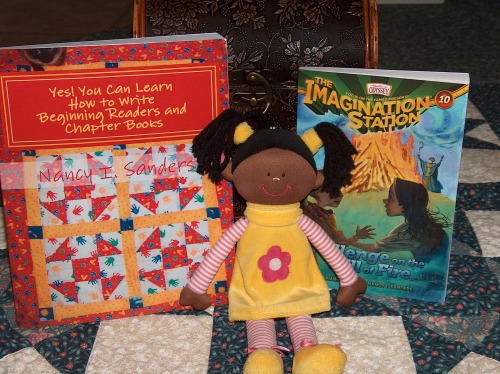Nancy I. Sanders's Blog, page 79
December 14, 2012
Character Development
Right now I’m under contract to write a brand new chapter book. It’s a “first chapter book” and is geared to a second grade reading level. Think “Magic Tree House” series by Mary Pope Osborne and you’ll know what level of book I’m working on.
This week I spent time working on the character development for all my background characters. This is actually one of my favorite parts of writing for kids! Below is an excerpt from my new book for writers, Yes! You Can Learn How to Write Beginning Readers and Chapter Books. It’s all about the process of character development for first chapter books. But not only are these tips helpful if you’re writing a chapter book, these are helpful if you’re writing magazine stories, picture books, and even novels for kids!
-Excerpt from Yes! You Can Learn How to Write Beginning Readers and Chapter Books:
Some of the most enjoyable experiences I have had as a writer were the times I developed the characters for the two first chapter book series I wrote for Concordia Publishing House. You can enjoy the thrill and delight along this enchanting journey as well when you create your own characters for this reading level.
Characters in first chapter books can be like splashes of bold and vivid colors across the pages of a book that for the first time in a young reader’s life are illustrated in black and white. Characters in first chapter books can be whimsical, endearing, lively and engaging.
It took me several months to develop the cast of characters in my first chapter book series, Marshal Matt: Mysteries with a Value. Before I started the process of character development, first I pitched an idea for a new series of first chapter books to my editor at Concordia. She was interested, so I brainstormed ideas for this series while I was busy working on a different book deadline.
When I worked with my co-author, Susan Titus Osborn, to write our Parables in Action series, it took time for us to develop the cast of characters, as well. We brainstormed a unique and enchanting character trait for each that would easily identify them from book to book in the series. Here is a list of the quirky and fun characters that we created:
Parables in Action series
Cast of Characters
Suzie: This is the main character whose voice tells each story. She always prays when the situation gets sticky. Each story and each character is seen through her eyes.
Bubbles: This is Suzie’s best friend. Bubbles’ real name is Nan. She is a child actress on TV and appears in a different costume in each book because she is always practicing for her next new TV role.
Mario: Suzie’s friend, Mario, likes to collect things. He’s very resourceful and comes up with all sorts of ways to raise money and fix problems.
Woof: Mario’s dog is named Woof. Woof is always running into a scene and barking, “WOOF!” at a key moment of the scene.
The Spy: He’s always writing spy notes in his spy notebook. The Spy’s real name is Larry. He always talks in secret code. For instance, “Iggle, iggle, snoogle, snoogle” means “yes.” When he says, “Ark, ark! Bam, bam!” he’s really saying, “Wow!”
Mr. Zinger: This is the classroom teacher of all the kids in this series. He has a beard, wears a baseball cap, plays the guitar, and sings with the kids. Mr. Zinger’s character traits are based on my husband, Jeff, who teaches fourth grade and plays guitar while singing with his students!
As you can see, characters in first chapter books can be over-the-top funtastic! Kids in first through third grade love reading about characters like these. Now you know why I had such a great time working to developing them.


December 12, 2012
Predictable Plots
Simple and predictable plots are winners with the earliest levels of easy readers. Don’t add too many elements to the plot structure that will cause young readers to pause to figure out what’s happening. They’re so focused on understanding each word and each sentence that adding complicated elements to the plot will overwhelm them and they will give up trying to read the story. You can help them focus even more on learning vocabulary and reading skills by choosing to structure your story in a predictable pattern.
Predictable plots that use repetition and a list or series of events to move the story forward can be very effective in the earliest levels of beginning readers. A surprise at the end is always a plus and leaves young readers feeling very pleased and satisfied when the story is over.
There are various plot structures you can utilize when writing emergent readers with predictable plots. Here are some of them:
Predictable Plots for Children’s Stories
Cumulative stories follow a plot where each time a new event occurs, all previous events are repeated. Think of the folk tale, This is the House that Jack Built.
Decreasing structure stories start with more and end with less. Five Little Monkeys Jumping on the Bed is an example that is also a counting story.
Increasing structure stories such as There was an Old Lady Who Swallowed a Fly start small and build up to a grand and glorious ending.
Full circle stories follow a round pattern because they begin and end in a similar way. Laura Numeroff is a master at writing circular stories, as demonstrated with her endearing picture book, If You Give a Mouse a Cookie, and other books she has written in that series.
Journey stories follow the main character on a quest that takes him or her to new places. The Lord of the Rings trilogy is an example for older readers of this classic plot structure of myths.
Pattern stories such as The Gingerbread Man have each new scene repeat the previous ones with only slight variations.
Question and answer stories such as the picture book Brown Bear, Brown Bear by Bill Martin develop the plot by asking repetitive questions with slight variations of text accompanied by repetitive answers with slight variations of text as well.
Sequence stories develop the plot based on counting with numbers, the alphabet, the days of the week, the months of the year or other predictable and familiar sequences. My book, D is for Drinking Gourd: An African American Alphabet is a picture book that incorporates the sequence of the alphabet from A to Z as part of its plot structure.
Not only are predictable plots used in beginning readers, however, they’re also used at times in magazine stories, picture books, and even children’s novels!
To learn more about writing predictable plots, check out my new book for children’s writers, Yes! You Can Learn How to Write Beginning Readers and Chapter Books. Get it for your writing buddy for Christmas or put it on your own Christmas list!


December 10, 2012
Beginning Readers Cover Photo
I was taking some photographs of my newest books so I could use them here on my blog and other places. So I just had to share about it with you! For starters, look at the cover of my book in the photo above. Yes, that’s my cat Pitterpat. When I was taking some photos of a quilt I made to use as the cover of my book, she decided to come join in the fun and posed up in the top left corner!
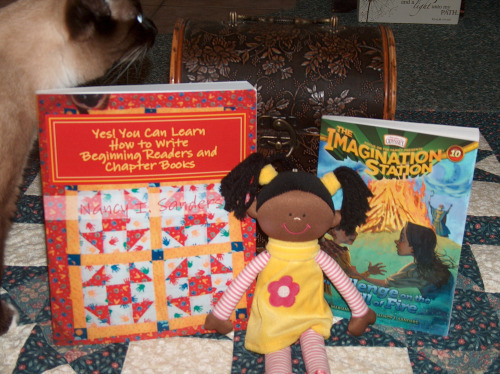
See my two new books in the photo above? Look closer. See Pitterpat at the top left? She always loves it when I get my camera out and she just had to check out these books, too. She especially wanted to see her photo on the cover of my new book, Yes! You Can Learn How to Write Beginning Readers and Chapter Books.
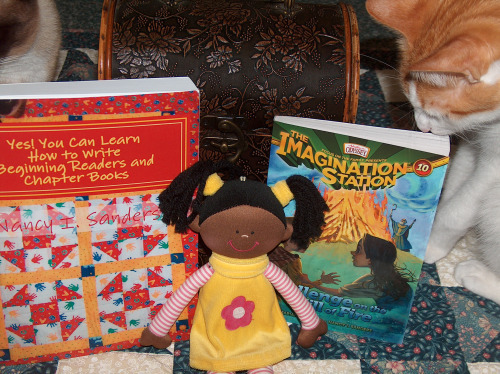
And then my other cat, Sandman, just had to come join in the fun. He wanted to see my two new books, too! That’s Sandman sitting in the right of the photo above.
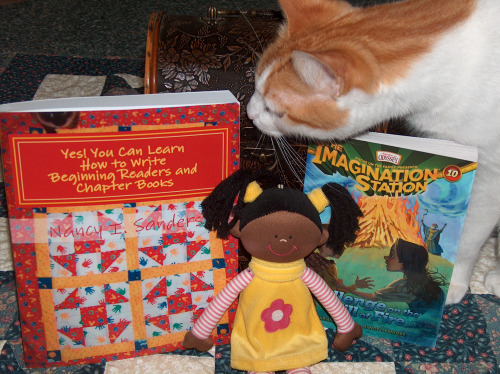
And hey! The photo above shows how Sandman is admiring Pitterpat’s photo on the cover of my book. So he decided he wanted to pose for a nice photograph, too. So here, in the photograph below is a picture of Sandman posing with my books.
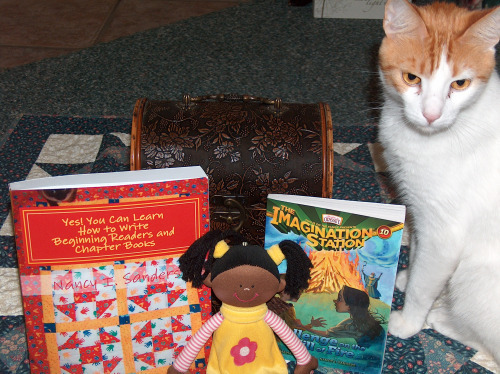
As you can guess, I love cats. In fact both Pitterpat and Sandman are my writing buddies. If I’m sitting on our couch typing away on my laptop, they’re both sleeping right next to me, usually one on my legs and one snuggled under my arm so they’re looking at the computer. And if I’m at my desk working on my computer, Sandman jumps up to the highest bookcase next to my desk and supervises my writing from there while Pitterpat usually sleeps on my lap.
And if you didn’t yet know, Pitterpat and Sandman are writers, too! In fact, they have their own website that features other writing buddies I’ve had over the years along with lots of fun tips and resources you can print out and use. Check out their website, Writing According to Humphrey and Friends.


December 7, 2012
Working Writers Club
Exciting news! My newest book, Yes! You Can Learn How to Write Beginning Readers and Chapter Books is featured in the spotlight at the Working Writers Club!
Check out all the wonderful resources you can find at the Working Writers Club. I’ve been a member of it and its other clubs for a number of years now. I’m always amazed at all the help it has to offer writers at every level and in every genre. The writing coach, Suzanne Lieurance is soooo helpful and has opportunities galore to help you move forward in your writing career.
And guess what? Right now membership is free!!! What a great Christmas gift you can give to yourself and your writing friends this year. So sign up and tell all your writer friends to sign up too!


December 5, 2012
Welcome to My World: Twins!
Sometimes our journey as a writer takes surprising twists and turns! This past week when not one, but two!, of my brand new books arrived at my house just one day apart from each other, I was amazed at how the path for these two books had come together.
Let me tell you a little bit about the stories behind the stories!
A couple of years ago, I started to write the first draft of the manuscript, Yes! You Can Learn How to write Beginning Readers and Chapter Books. You see, I had written and published a number of leveled readers over the years.
What are leveled readers? They’re stories that are written for someone who can read at a certain age level in school.
I have written leveled readers for teachers to use with elementary kids for Scholastic Teaching Resources. Nineteen books in all with about 20 stories in each book. One of these books is a bestseller for Scholastic with over 250,000 copies sold to date.
I’ve written leveled readers for middle grade students for 2 books for Libraries Unlimited. Again, about 20 stories in each book.
I’ve written first chapter books for Concordia publishing. Two series of books, actually.
In fact, beginning readers and chapter books have been the bread and butter of my writing career.
So I thought it was about time to sit down and write a book on how to write these fun stories and get them published in today’s market. I want YOU to be able to experience the fun and success that I have, too. And I know you can, because leveled readers are still in demand even though the market is tight in other areas for children’s writers.
Some books take awhile to get from written manuscript to published book. That’s how it has been with my new how-to-write book for beginning readers. Finally, this past summer, it was polished and nearing the completion of the publication process.
So imagine my surprise in August this past summer, as I was getting ready to launch my new book on how-to-write beginning readers and chapter books, when I landed a whole new contract to write more chapter books in a series that had already been started. I was brought on board to write Book 10 in the series of leveled readers for kids in second grade.
And then imagine my even greater surprise when that finished chapter book was sent to me just 3 months later in the same week that I got my how-to-write-chapter-books book that had taken years to also get published!
Talk about amazing timing!!!


December 3, 2012
Welcome to My World
This last week was quite an exciting week here at our house. Not one, but two, of my new books arrived in the mail! I feel like I’ve had twins!
The first book to arrive is my newest “how-to” book for children’s writers. It showed up on my doorstep on Thursday. Here’s a picture of the cover. (I just had to show you my new baby!)
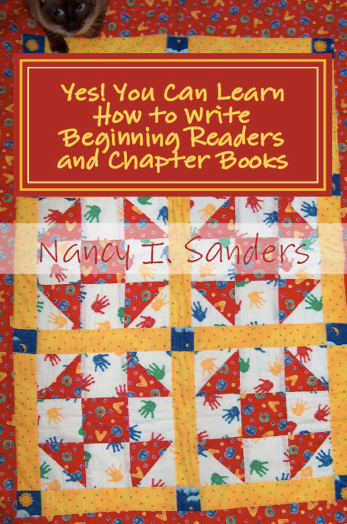
Yes! You Can Learn How to Write Beginning Readers and Chapter Books
Available on Amazon
And here’s a picture of my other baby! It arrived in my mailbox the very next day, last Friday.
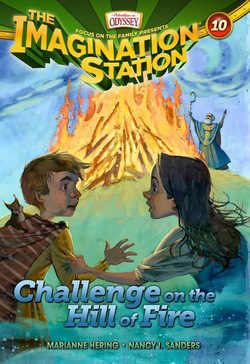
Imagination Station Book #10
Challenge on the Hill of Fire
Soon to be available on Amazon.
As you can guess, I just had to share the announcement with you!!! And it’s so fascinating that both these books arrived within one day of each other. Truly they are twins because they have so much in common…but more about that in an upcoming post! So stay tuned!!!!


December 1, 2012
Writing a Mystery for a Children’s Magazine: Part 2
When writing a mystery for a children’s magazine, here are a few pointers to remember:
#1: Each magazine has its own preferences for stories they like to publish. Study the mysteries your target magazine publishes and craft yours to have a similar feel. If your target magazine doesn’t yet publish mysteries but you’d like to submit one to them, study their fiction stories in general to note the plot development, character development, use of dialogue and pace of the action.
#2: The word count in a magazine story is not very high. Usually it tops out at 700 to 1500 words. This is a big contrast to chapter books or middle grade novels where mysteries can be developed in a much more in-depth process. Your mystery has to start with a pop, get hopping, and wrap up with a surprising and very satisfying bang!
#3: In a magazine story there’s not a lot of room for character development, so give each one of your characters, especially the detective and the suspects, their own unique character tag. For example, make one suspect sneeze between every other sentence because he’s allergic to the cat. Make another suspect always wear a baseball cap. Make another suspect wear a lot of bling. And make your detective have an endearing quirk such as loves to eat pickles when searching for clues. The big crunchy juicy pickles that squirt his suspects in the eye as he takes a bite!
#4 Because there’s not a lot of room for a big word count, drive the action of your story through lots of dialogue so we hear and see what’s happening instead of just being told. Not only does this save on word count but it helps you “show, not tell.”
So, put pen to paper and have fun writing mysteries for children’s magazines!


November 29, 2012
Writing a Mystery for a Children’s Magazine: Part 1
When writing a mystery for children in general, there are basic ingredients your story should have:
Problem: A mystery usually starts with a problem that involves a crime or mysterious unknown. Somebody is needed to solve the problem and get all the questions answered. Think whodunit!
Characters:
*Detective or main character (MC) whose job it is to solve the crime or mysterious problem.
*Suspects: Each one of these must have a valid reason or motive they might have committed the crime or caused the problem. They also must have had the potential opportunity to do it.
Clues: The actual person who committed the crime has to leave a trail of clues that the detective or MC can find.
*Red herring: This is a clue that actually misleads the detective and points to the wrong suspect. A red herring isn’t necessary, but it’s always a plus.
Conclusion: A mystery concludes with the crime being solved and the questions being answered. The reader needs to feel satisfied with how the story ends. The tricky part about the conclusion is that it needs to hold an element of surprise or an ah ha! moment. It can’t be predictable or a magazine won’t publish it.


November 27, 2012
Writing for Children’s Magazines
Today I wanted to post about writing for children’s magazines. Thanks, Chris, for asking about this!
Here basically are a few pointers:
1) To get your foot in the door with a children’s magazine, start submitting fillers. Fillers are puzzles, crafts, recipes or other small articles that most children’s magazines include in their issues. Why start with fillers? The magazine needs more fillers and usually fewer authors submit fillers so your chances of getting an acceptance letter are better. Plus, these are usually easier to learn to write rather than fiction stories.
2) Also try submitting nonfiction articles. Once again, fewer authors submit these so you have a better chance of getting an acceptance letter.
3) If you also want to try your hand at submitting fiction stories to children’s magazines, go for it! Just don’t be too disappointed if you receive a rejection letter. Competition is fierce for feature fiction stories and most magazines only include 1 or 2 each issue which means they only need 12-24 each year.
Each magazine is so different in their preferences for fiction that the best way to go about this is to get about a year of back issues at your local library or thrift store. Find several fiction stories that have a similar plot structure or feel similar (for example several stories featuring animals as main characters). Type these out on your own computer. Then try to figure out their basic plot structure by noting:
a) The Beginning: How was the story set up? What is the main story problem? How were the characters introduced?
b) The Middle: How did the main character (MC) attempt to solve the problem? Identify each attempt.
c) The End: How did the story build to a climax? How did the MC change? How did the MC solve the problem? How did the story conclude?
For more information about how to write for magazines, check out the section on this subject in my book for writers Yes! You Can Learn How to Write Children’s Books, Get Them Published, and Build a Successful Writing Career.


November 23, 2012
Steps to Finding an Agent: Part 9
Step 9
9. I basically started the process all over again. I went through this list of big New York agents who owned their own agency with just one or two other agents working with them. I studied the various websites and interviews and blogs and I chose my favorite agency that topped my wish list of these agents.
I wrote up a brand new picture book manuscript and targeted it to this agent’s preferences that I discovered while studying her client list and her list of books she repped. Plus I went to a local SCBWI conference where I met one of the agents at her agency. I used the same strategies to target this second list as I did for my first list…
And the great news was that my journey for searching for an agent came to a successful end. I landed a contract with my top choice on this list. I never even had to send out any more simultaneous submissions because this agent responded immediately and things progressed from there over the next 6 or 7 months toward signing a contract.
Now, if I hadn’t gotten accepted by this agent, I would have gone down my list and submitted to every agent in this group. And if those had all come back as rejections, I was planning to send simultaneous submissions to all the small agencies I liked on the third chart I had been compiling.
So from start to finish, it took me about 1 ½ years of focused submissions to find my picture book agent.


Nancy I. Sanders's Blog
- Nancy I. Sanders's profile
- 76 followers


